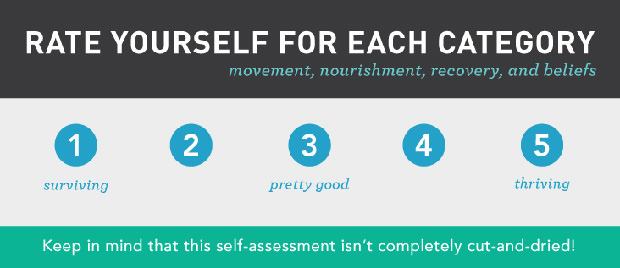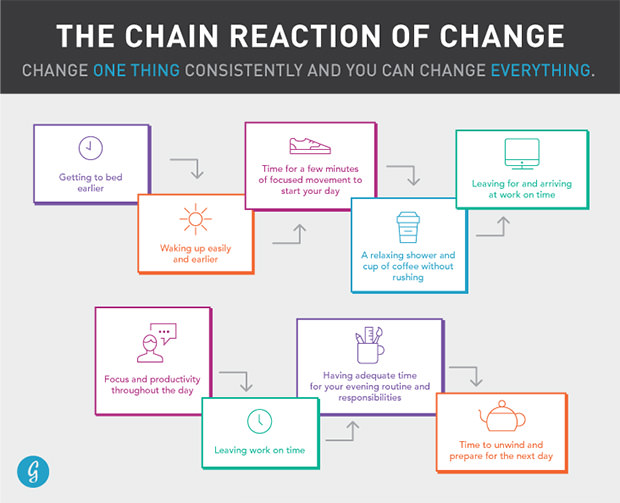
Nail Every Fitness Goal You Set

Posted on 04 Nov, 2019

Whatever your fitness or performance goal—lose weight, build strength, run a faster 5K, you name it—establishing the right environment for yourself is the foundation for your sustainable success.
It's so easy to fall prey to the idea that every goal has a simple, linear solution: "Losing weight equals moving more and eating less;" "toning up means lighter weights for more reps;" "running faster equates to including intervals." While there is some truth to these approaches, they're only part of the puzzle.
The Big Four
The first step on any fitness journey is to step back and consider the bigger picture of your environment. Your environment—all the facets of your life that impact your ability to achieve and sustain your goals and to live the life you deserve and desire—is built around four core areas: movement, nourishment, recovery, and belief.
By taking a look at each of these, you can determine whether you’re operating in survival mode or in a thriving state. (Spoiler alert: Fitness and performance goals are not priorities for our bodies when we're in survival mode. In other words, your body doesn’t care that your mind wants to look better or lift more when you're lacking quality nutrition and restorative sleep.)
So what does survival mode look like? Unfortunately it's probably very familiar: eating on the run, not getting enough sleep, relying on coffee and energy drinks to make it through the day, not making the time to decompress, engaging in negative self-talk, and putting yourself last. Can you achieve success in an environment of these conditions? Possibly, but I’d ask: At what cost will your success come? More importantly, are you interested in making a fundamental change to your environment or just a short-term tweak that will result in a short-term gain?
On the other hand, when you’re operating in a thriving state, you wake up with ease, feeling refreshed from a restorative night's sleep. You enjoy a nourishing breakfast without feeling rushed, and you even have time to digest your food and enjoy a cup of coffee. You have a reservoir of energy—not the kind of excess energy that makes you feel jittery or anxious; rather, the kind that makes you feel vital and confident enough to deal with the demands of life. You are actively engaged in life and being "fit" has less to do with the gym specifically and more to do with how you're living your life overall. Your schedule is focused and priorities are set straight, and you’re making decisions consistent with your life values.
By taking care of your body’s fundamental needs for healthy movement, quality nourishment, regenerative sleep, and a positive mindset, you are propelling yourself into an environment that gives you an edge on life.
Put simply, losing weight and getting in shape has everything to do with your environment and less to do with eating less and moving more. As proof, consider that research has shown a lack of sleep minimizes weight loss and can even lead to poor eating choices. Unless your body gets what it needs, you can’t expect it to give you what you want.
To determine whether you're thriving or surviving, take a closer look at your environment.


Movement (1-5)
- Do you lead an active lifestyle? (Remember: It’s possible to exercise every day, yet be sedentary otherwise.)
- Is your movement (whether working out, on the job, etc.) healthy and comfortable? (For example, you may perform well but struggle with aches and pains.)
- Is your approach to movement comprehensive? (Do you foam roll, mobilize your joints, warm-up and cool-down efficiently?)

Nourishment (1-5)
- Do you eat fresh, whole foods? (Eating restaurant food frequently is associated with weight gain and processed, packaged foods have been shown to be less healthy than whole foods. .
- Do you have a balanced approach to eating? (Diets that promote limited or excessive amounts of proteins, carbs, and fat could stress you and your body more.)
- Do you rush when eating, or take time to enjoy your food? (Eating quickly has been shown to result in more calories consumed and feeling full for shorter periods of time.

Recovery (1-5)
- Do you have high sleep quality? (Being able to fall and stay asleep, and wake up easily are important considerations.)
- Do you sleep seven to eight hours per night? (Chronically sleeping less than seven hours tends to keep the body in survival mode.)
- Do you have scheduled downtime? (Having time to decompress, relax, and reflect helps restore your body from the stress of life.)

Beliefs (1-5)
- Do you have more self-limiting or self-affirming beliefs about yourself? (Self-limiting beliefs can make you feel like attempting positive change is too difficult, while self-affirming beliefs lead to making choices that align with what you feel is important.)
- Do you have more of a “fixed” or “growth” mindset? (Fixed mindsets often lead to the path of least resistance while growth mindsets embrace new challenges. If you have a fixed mindset, you might think, "I’ve always eaten what I wanted and exercised this way so eventually this has to work." With a growth mindset, you may think, "This approach is completely different but I’m willing to give it a shot; I’m open to learning something new and I can probably grow from it.")
- Are your behaviors consistent with your values? (Try to notice if, even if you value health, comfort, or your appearance, your behaviors don't support those values.)
What's the Score?
Add up your total score and divide it by 20 (the highest possible score). The resulting number is a percentage that indicates how well you’re managing your environment. For example, if your total score is 10, you’re operating at 50 percent of your potential (10 ÷ 20 = 50%). Remember, a smaller percentage just means you have plenty of opportunities for improvement. For any facet of your environment in which you scored yourself lower than a 4 or 5, jot down a few ideas about what you can do to enhance that area of your life.
Tips and Takeaways
Here are a few ideas to help you start making improvements in each facet of your environment.
Movement
- Train and condition your body for life by working out to your threshold (i.e. not too intensely and not too lightly). Training “just right” at your threshold will challenge you, but not so much that you can’t sustain the effort.
- Schedule time for one recreational activity each week outside of a gym.
- Pay your body back with foam rolling and joint mobility exercises to improve movement, health, and comfort.
Nourishment
- Prepare simple recipes ahead of time to accommodate your hectic lifestyle. This is healthy "fast food."
- Consume foods from within your local environment and support local farms.
- Consume real foods to help your body create authentic energy. By choosing unprocessed foods, your body can easily break these down and properly fuel yourself for the demands of your life.
Recovery
- Schedule one hour of unstructured relaxation time each day.
- Self-massage with a foam roller each day before bed to help you relax into sleep.
- Set a "lights out" time and stick to it.
Beliefs
- Focus on making ONE positive change within your environment for 30 days. ONE CHANGE ONLY.
- Behave to become. Behaving yourself in accordance with your values helps build confidence. Write down what you value and every day (or every week) take a minute to re-read this list and remind you of why you’re doing what you’re doing.
Encouraging others to reach their full potential simultaneously fuels your efforts.

This piece was written by Mike Rizk, founder of Condition for Life and self-proclaimed biomechanics geek by day and mean hacky-sacker by night. Based out of Central Jersey, Mike gets his kicks being a father and unlocking people's hidden potential by sharing the message of being conditioned for life.
Photo Credits
Great Books On Writing Your Own Destiny

by Jon Kabat-Zinn

by Osho


 16 Secrets To A Happy Life
16 Secrets To A Happy Life How To Get Out Of Work Earlier
How To Get Out Of Work Earlier 14 Tips For Starting Your Morning Off Right
14 Tips For Starting Your Morning Off Right The Pacific Crest Trail In Three Minutes
The Pacific Crest Trail In Three Minutes










